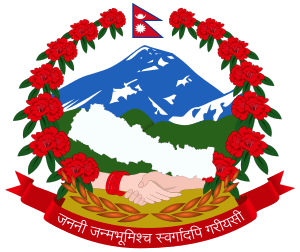Rastriya Panchayat
 |
|---|
| This article is part of a series on the politics and government of Nepal |
|
Executive:
Judiciary:
|
|
|
|
Related topics |
Rastriya Panchayat was the official legislature (parliament) (parliament) during the Panchayat regime of Nepal that effectively functioned from 1960 to 1990.[1] Its head office was at the "Gallery Baithak" in Singha Durbar, Kathmandu. In the 1980s, it consisted of more than 120 members among which 105 members were directly elected by the people, while the king was to nominate 20 percent of its members, i.e. 19 members were nominated by the monarch.
The Rastriya Panchayat was dissolved by King Birendra after the People's Movement I in 1990[2] and replaced by a bicameral legislature with a fully elected House of Representatives (Nepali: Pratinidhi Sabha).
Some notable Rastriya Panchayat members
- Dr. Tulsi Giri (First Prime Minister of Panchayat System)
- Surya Bahadur Thapa (Former Prime Minister)
- Kirti Nidhi Bista (Former Prime Minister)
- Nagendra Prasad Rijal (Former Prime Minister)
- Lokendra Bahadur Chand (Former Prime Minister)
- Marich Man Singh Shrestha (Former Prime Minister)
- Nawaraj Subedi (Former Defense Minister and Chairman of Rastriya Panchayat)
- Giri Prasad Burathoki (Former Defense and Assistant Minister)
- Padam Thakurathi
- Hem Bahadur Malla
- Dirgha Raj Prasai (Former Consultant of Nepal Administrative Staff College and Former Adviser Ministry Development Committee) [3] [4]
- Bhim Prasad Gauchan [5]
- Dharma Prasad Upadhyaya [6]
- Dambar Bam [7]
- Bhim Bahadur Shrestha [8]
- Ram Raja Prasad Singh [9]
- Dr. Prakash Chandra Lohani [10]
References
- ↑ "Endangered Archives".
- ↑ "Nepal: CA body similar to last Rastriya Panchayat, claims Dahal".
- ↑ "Facebook account".
- ↑ "Official Facebook Page of Dirgha Raj Prasai".
- ↑ "The View Points" (PDF).
- ↑ "Political Events from 2017 BS to 2036 BS".
- ↑ "Dambar Bam".
- ↑ "Nepali Congress".
- ↑ "A gentle revolutionary".
- ↑ "Constitution by May 28 is getting doubtful: Dr Lohani".
This article is issued from
Wikipedia.
The text is licensed under Creative Commons - Attribution - Sharealike.
Additional terms may apply for the media files.